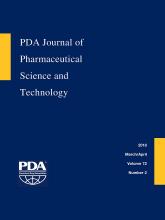Abstract
Processing equipment involving grinding of two solid surfaces has been demonstrated to induce subvisible particle formation in monoclonal antibody drug product manufacturing processes. This study elucidated potential stress types associated with grinding action to identify the stress mechanism responsible for subvisible particle formation. Several potential stress types can be associated with the grinding action, including interfacial stresses (air–liquid and liquid–solid), hydraulic/mechanical shear stress, cavitation, nucleation of stressed protein molecules, and localized thermal stress. More than one stress type can synergically affect monoclonal antibody product quality, making it challenging to determine the primary mode of stress. Our strategy was to assess and rule out some stress types through platform knowledge, rational judgments, or via small-scale models, for example, rheometer/rotator-stator homogenizer for hydraulic/mechanical shear stress, sonicator for cavitation, etc. These models may not provide direct evidence but can offer rational correlations. Cavitation, as demonstrated by sonication, proved to be quite detrimental to monoclonal antibody molecules in forming not just subvisible particles but also soluble high-molecular-weight species as well as low-molecular-weight species. This outcome was not consistent with that of grinding monoclonal antibodies between the impeller and the drive unit of a bottom-mounted mixer or between the piston and the housing of a rotary piston pump, both of which formed only subvisible particles without obvious high-molecular-weight species and low-molecular-weight species. In addition, a p-nitrophenol model suggested that cavitation in the bottom-mounted mixer is barely detectable. We attributed the grinding-induced, localized thermal effect to be the primary stress to subvisible particle formation based on a high-temperature, spray-drying model. The heat effect of spray drying also caused subvisible particles, in the absence of significant high-molecular-weight species and low-molecular-weight species, in spray-dried monoclonal antibody powders. This investigation provides a mechanistic understanding of the underlying stress mechanism leading to monoclonal antibody subvisible particle formation as the result of drug product processing involving grinding of solid surfaces.
LAY ABSTRACT: Subvisible particles present in therapeutic protein formulations could adversely affect drug product safety and efficacy. We previously illustrated that grinding action of the solid surfaces in some bottom-mounted mixers and piston pump is responsible for subvisible particle formation of monoclonal antibody formulations. In this study, we delved into mechanistic understanding of the stress types associated with solid surface grinding. The approach was to employ several scale-down stress models with known stress types. Protein formulations stressed in these models were analytically characterized for subvisible particles and other degradants. Some commonly known stress types—such as air–liquid interface, mechanical stress, cavitation, nucleation, and thermal effect—were assessed in this study. The stress model yielding a degradation profile matching that of bottom-mounted mixers and piston pump warranted further assessment. Localized, thermal stress proved to be the most feasible mechanism. This study, along with previously published results, may further advance our understanding of these particular drug product manufacturing processes and benefit scientists and engineers in overcoming these development challenges.
- Grinding stress
- Monoclonal antibody
- Subvisible particles
- HMWs
- LMWs
- Cavitation
- Sonication
- Thermal stress
- Spray drying
- © PDA, Inc. 2018
PDA members receive access to all articles published in the current year and previous volume year. Institutional subscribers received access to all content. Log in below to receive access to this article if you are either of these.
If you are neither or you are a PDA member trying to access an article outside of your membership license, then you must purchase access to this article (below). If you do not have a username or password for JPST, you will be required to create an account prior to purchasing.
Full issue PDFs are for PDA members only.
Note to pda.org users
The PDA and PDA bookstore websites (www.pda.org and www.pda.org/bookstore) are separate websites from the PDA JPST website. When you first join PDA, your initial UserID and Password are sent to HighWirePress to create your PDA JPST account. Subsequent UserrID and Password changes required at the PDA websites will not pass on to PDA JPST and vice versa. If you forget your PDA JPST UserID and/or Password, you can request help to retrieve UserID and reset Password below.






